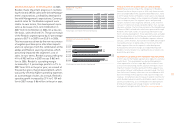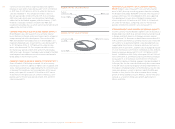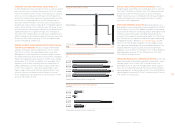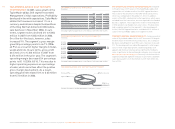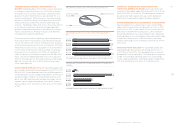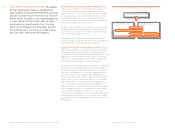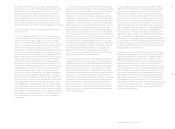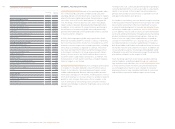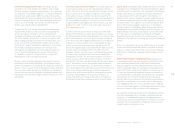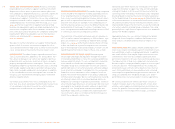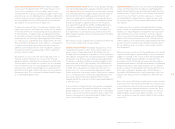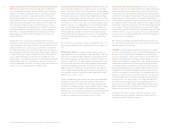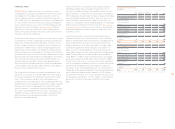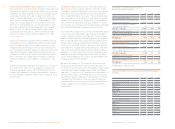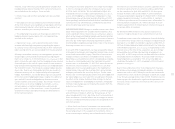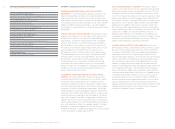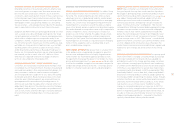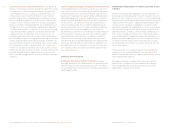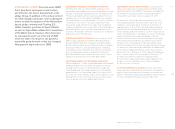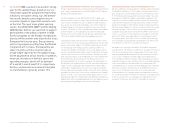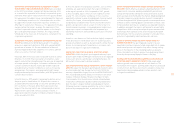Reebok 2007 Annual Report Download - page 113
Download and view the complete annual report
Please find page 113 of the 2007 Reebok annual report below. You can navigate through the pages in the report by either clicking on the pages listed below, or by using the keyword search tool below to find specific information within the annual report.109
ANNUAL REPORT 2007 --- adidas Group
03
RISKS FROM RISING INPUT COSTS Raw material and labor
costs account for approximately 70 % of the Group’s cost of
sales. Prices of materials such as rubber, which closely
correlate with the oil price, are especially subject to the risk of
price increases. As our ordering process and price negotiations
usually take place around six months in advance of production,
our sourcing function has visibility and reaction time to man-
age and plan for sharp increases in input costs.
To reduce the fi nancial impact on our product margins from
higher sourcing costs, we collaborate closely with our vendors
to increase effi ciency in manufacturing processes and search
for new materials. In addition, we have exploited economies
of scale from our higher sourcing volume following the Reebok
acquisition and are constantly improving production effi ciency.
see Global Operations, p. 062 We may also compensate for this risk
by increasing the selling prices of our products – although this
is subject to the prevailing consumer and retail climate. In
addition, in the medium term we have the ability to adapt our
sourcing structure to take advantage of more competitive
pricing in other locations.
We continue to assess the risks from rising input costs as
having a medium likelihood. As a result of the time lag
between ordering and production, we believe the short-term
fi nancial impacts from input cost increases are low. However,
with the sharp oil price increases during 2007, ongoing wage
infl ation in Asia and increasing freight costs, we believe the
potential fi nancial impact from rising input costs has grown for
the medium term. This could have a medium fi nancial impact
on our profi tability beyond 2008.
SUPPLIER DEFAULT RISKS Over 95 % of our product offering is
sourced through independent suppliers mainly located in Asia.
see Global Operations, p. 062 To reduce the risk of business interrup-
tions following a potential supplier default, we work with ven-
dors who demonstrate reliability, quality, innovation and
continuous improvement. In addition, we have bought insur-
ance coverage for the risk of business interruptions caused
by physical damage to supplier premises. The Group has
also signifi cantly reduced the number of independent manu-
facturers by combining the adidas and Reebok sourcing
organizations. This exercise has allowed us to reduce risk
by simplifying our sourcing structure, and focusing on the
highest- quality suppliers, without compromising our fl exibility
or competitiveness.
We continue to assess supplier risks as having a low likelihood
of occurrence and potential fi nancial impact.
PRODUCT QUALITY RISKS The adidas Group faces a risk of
selling defective product, which may result in injury to con-
sumers and / or image impairment. We mitigate this risk
through rigorous testing prior to production, close cooperation
with suppliers throughout the manufacturing process, random
testing after retail delivery, open communication about defec-
tive products and quick settlement of product liability claims
when necessary. In 2007, approximately 3,400 FSMK hockey
masks which were delivered to retail in Canada, Europe and
the USA, were subsequently recalled voluntarily due to a
quality issue. The issue arose during subsequent random
testing of products after market launch. During these random
tests, a hockey puck was aimed at full speed directly at the
face masks. Many of the masks dented and the coating
chipped slightly. No incidents or injuries were reported before
or after the recall.
Our assessment of product quality risk remains unchanged
versus the prior year. We regard the likelihood of signifi cant
product liability cases or having to conduct wide-scale product
recalls as low. As we have insurance protecting us against the
fi nancial consequences of signifi cant product liability cases,
we also assess the fi nancial impact as low.
CUSTOMER RISKS Customer risks arise from our dependence
on key customers who have the ability to exert bargaining
power and can therefore cause considerable margin pressure
or cancel orders. These risks exist not only due to the relative
size of some of our major customers, but also as a result of
our limited ability to impact how they conduct business and
the external impacts of the consumer environment in which
they operate.
To limit these risks, we utilize a broad distribution strategy
which includes our expanding controlled space activities. This
enables us to reduce negative consequences that result from
sales shortfalls that can occur with key customers. Specifi -
cally, no customer at brands adidas, Reebok and TaylorMade-
adidas Golf accounted for more than 10 % of brand sales in
2007. In addition, we are proactively cooperating with key retail
partners to further optimize sales through innovative point-
of-sale initiatives (e. g. our shop-in-shop concepts at Dick’s
Sporting Goods).
When necessary, we also restrict the distribution of our brands
to protect brand image or product margins, and to streamline
supply. For example, in the course of 2007, the Group decided
to limit the Reebok product offering to an important mall-
based key account in North America who had continually dis-
counted Reebok product. Although we have been strengthening
Reebok’s business in other retail channels such as sporting
goods, we expect this development will have a signifi cant neg-
ative impact on Reebok segment sales in North America
throughout 2008. Nevertheless, the Group projects only a low
impact on the Group’s overall contribution in 2008 from this
action.
Due to the current diffi culties at mall-based retailers and the
overall economic environment in the USA, we continue to view
a strong reduction of business with one of our brands’ biggest
retailers as having a medium likelihood of occurrence. Such
an event could have a medium fi nancial impact on the sales
and profi tability of a particular region. However, on a Group
level, we continue to view the fi nancial impact from customer
risks as low.


